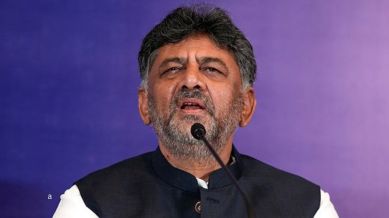Stay updated with the latest - Click here to follow us on Instagram
Karnataka caste census: ‘Extension of govt’s Muslim appeasement’ says BJP, Shivakumar claims ‘no hasty decision’
The report, which was tabled before the Cabinet on Friday, pegged Muslims to be the largest single group and recommended reservations for OBCs to be hiked from the existing 32% to 51%.

The Socio-Economic and Educational Survey report of the Karnataka State Backward Classes Commission, which pegged the population of Other Backward Classes (OBCs) in the state at 69.6% and recommended increasing quota for these communities from the existing 32% to 51%, has led to a political tussle in the state.
Terming the report as an “extension of the Siddaramaiah government’s Muslim appeasement” and labelling it “unscientific”, Leader of the Opposition in the Assembly, R Ashoka said: “Imagine the extent of conspiracy. The report shows Muslims as the most populous group in the state.” Ally JD(S) too slammed the government. Even before the findings of the report were leaked, JD(S) leader and Union minister H D Kumaraswamy on Saturday called it a “ploy to divide society”.
monthly limit of free stories.
with an Express account.
According to the report, Scheduled Castes (SCs), numbering 1.09 crore, form the largest chunk of the state’s population followed by Muslims under the Category 2B of the OBCs, at 75.25 lakh. The report pegs the number of most backward classes among the OBCs at 1.08 crore of which 34.96 lakh, including communities like Golla and Besta, fall under the 1A Category while 73.92 lakh, including Kurubas falling under the 2B Category.
Castes like Billava, Ediga and others, which fall under the 2A Category number 77.78 lakh while the 3A and 3B categories, which include dominant communities like Vokkaligas and Lingayats, have been numbered at 72.99 lakh and 81.37 lakh respectively.
Among the most populous caste groups are the Lingayats – seen to be a core voter base of the BJP – who number around 76 lakh while the Vokkaligas, who traditionally rally behind the JD(S) but are seen to be shifting towards the Congress due to Deputy CM D K Shivakumar, have been pegged at 42.71 lakh. The report pegs the number of Kurubas, the community to which Siddaramaiah belongs, at 42.71 lakh while Christians are around 9.5 lakh.
The commission has recommended enhancing the reservation for Category 1 from the existing 4% to 18%, reducing quota under the 2A Category from the existing 15% to 10%, increasing it for the 2B Category from 4% to 8%. For the 3A and 3B categories, the panel recommended hiking the reservation from the existing 4% and 5% to 7% and 8% percent, respectively. It did not recommend changes in the existing reservation of 15% and 3% for the SC and ST communities, respectively.
The survey, popularly referred to as caste census, was commissioned during Siddaramaiah’s first term in 2015 and on Friday, was tabled before the state Cabinet, which is likely to discuss it on April 17. The survey was carried out under H Kantharaju, former chairman of the commission but its report was submitted last year in February, when Jayaprakash Hegde headed the panel.
The caste census has been a controversial subject since the Congress government decided to accept it after assuming power in May 2023 with the Vokkaligas and Lingayats opposing it even as SC communities have demanded that it be made public. The Vokkaligara Sangha and the All India Veerashaiva Mahasabha, which represent the Vokkaligas and Lingayats respectively, had voiced concerns over it as they suspected “undercounting” of their respective communities.
Meanwhile, the state government defended the caste census with Siddaramaiah himself dismissing allegations that the report was unscientific.
On the other hand, Shivakumar, who is reportedly apprehensive over the report being made public, said everyone would be given an opportunity to discuss it. “It is our duty to ensure justice for everyone. There will be no hasty decision taken by the government,” he said but also added that he would not criticise anyone opposing it.